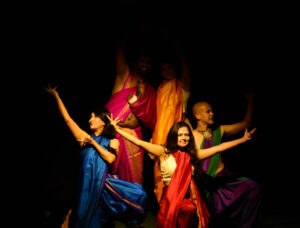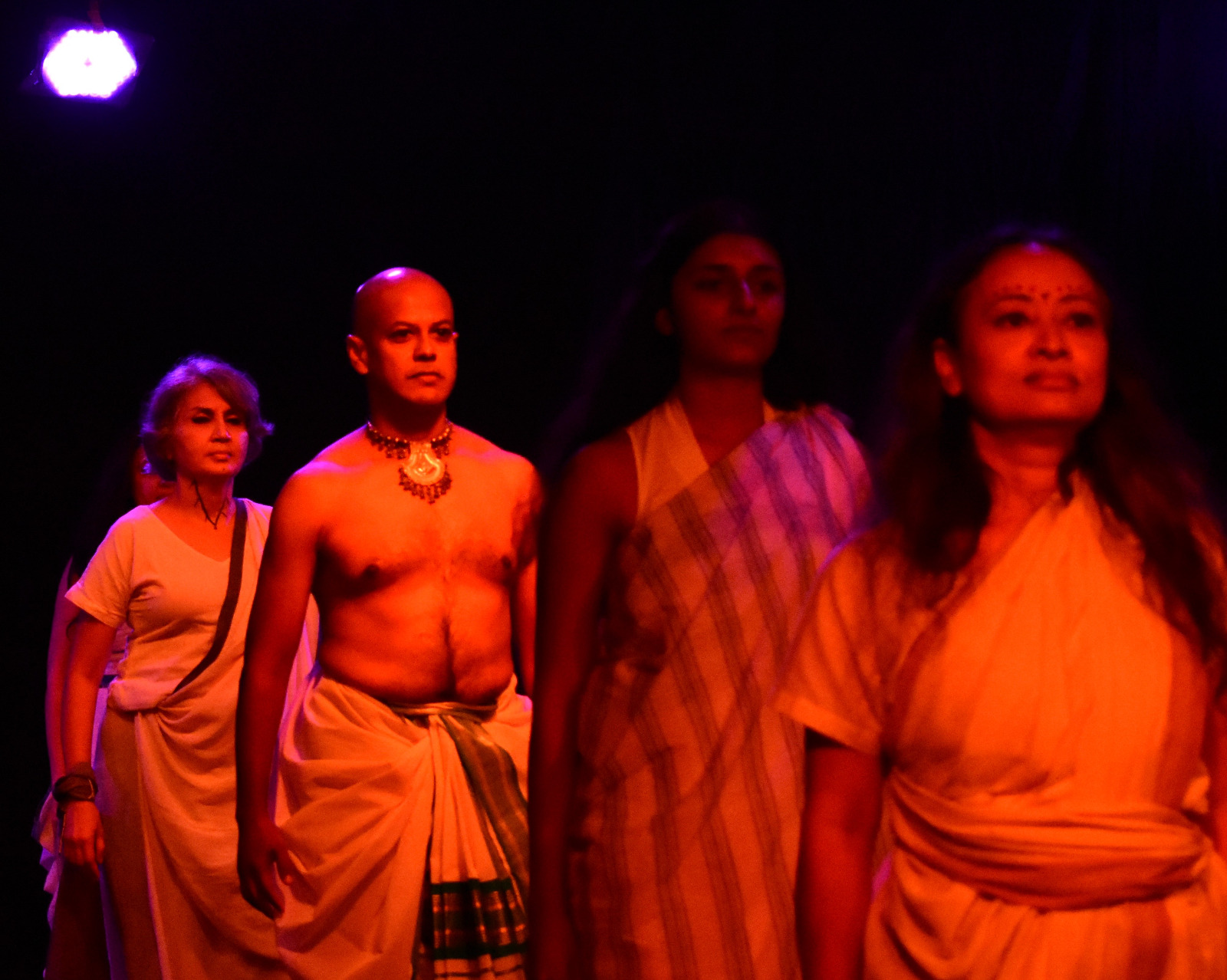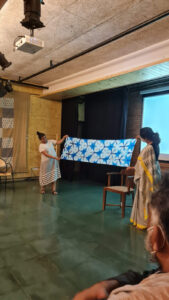WORKSHOP FOR CHILDREN
We dived into the week with a colourful, interactive and fun workshop for children of all ages. It was
conducted by My Little Bookshop which is a curated online store for books, toys and early learning
resources. The children learnt how to weave with the wonderful kits provided by the team. The kit
had a loom, a needle and a beautiful range of thread that could be anything from plain cotton to
shoelaces to any waste material. The activity itself was for them to make a mini tapestry with the
thread given. You can get creative with their looms and make anything from coasters to table mats.
Activities like these bring about great exposure to children in a very fun way. The children thoroughly
enjoyed creating their masterpieces.
Website: mylittlebookshop.in
KAWDI QUILTING WORKSHOP
Brinda, the facilitator of this workshop, takes all the participants on a journey of kawdi. She teaches
them how to quilt while educating them about the rich history behind this art form. Traditionally all
quilting across the world was a way of using scraps of fabric. Members of the Siddi ethnic tribe, of
African origin, have spread across the Uttara Kannada district. While assimilating into the society
they live in, they have retained some traditional skills and one such skill is quilt making which was a
large community activity. The Kawadi was always made by hand on a layer of old saris, and the
borders were used to frame the quilt. The tribe also takes the liberty of embroidering stories on their
quilts. The participants were told to start with the border and then work their way in. They used pearl
cotton thread and cotton cloth, though traditionally just cotton thread and any old cloth were used.
The whole piece is done with a simple running stitch, starting from the borders and adding layers of
cloth as they go. They also put diagonal stitches at the edges and learnt how to iron the cloth with
their hands to keep the kawdi in place. All the participants thoroughly enjoyed this workshop and
were very happy to have started this journey by making their very own pieces!!
YARN SPEAK: SARAH THOMAS
Sarah is passionate about textiles, designs clothing and home furnishings under the brand name
‘Umoya’. Her work involves using Batik and Shibori techniques. This talk educated the audience on
the different varieties of Shibori. At first, Sarah spoke about the Japanese itajime method which
involves cloth that is clamped between two blocks to result in beautiful geometric designs. Next was
the African nori shibori which is done with a simple running stitch. The third was Arashi or Pole tied
shibori where the whole setup is around a pole, this gives a wave-like and watery effect on cloth.
Lastly, she spoke about the Indian Kumo or pleated shibori which requires no stitching but the
wrapping of cloth. Nowadays shibori is more mechanised with silk or cotton cloth. The cloth is
usually dyed with Azo-free acidised dye, but sometimes vegetable dyes are used though they have a
longer process and a lesser life span. At the end of the presentation Sarah surprised us with a
freshly dyed piece which she opened for the first time right in front of the audience.
TEXTILE HISTORY OF BANGALORE
The guest speaker, Suresh Jayaram, is a visual artist and an anthropologist who is trained as an art
historian, arts administrator and curator from Bangalore. He is the Founder of 1. Shanhtiroad Studio.
His love for fabric blossomed at a young age when he would observe the cotton cloth his mother
wore and the khadi his father wore. The whole talk was an interactive conversation with the
audience which started with the question “who bought silk to India?’. Tipu who was keen on material
and horticulture constantly requested gardeners, fruits and silk from Europe and this is how silk was
first introduced. Everybody then reminisces about the famous stores and streets where the cloth was
sold in the 1900s from Pete areas to sampangiramnagar silks and Chamundi silks. They talk about
the diversity in something as simple as a sari where every state in India has a different style. The
second half of this talk was a presentation on the ‘Urban Fabric Project’ which was a show curated
by Suresh Jayaram himself. The show had different kinds of cloth, tapestries, art through cloth,
stories on textiles, The darzi project and so on. Many students of Jayaram had exhibited their work.
He spoke about some memorable installations like The nighty project, jeans with poems, the big
saree installation, quilts from the Siddi community and many more. Later with the audience, He
explored different anecdotes of the past such as the Mysore maharajas inviting weavers from all
over the world to create different kinds of silk and how stitched cloth only came into play after the
Mughal era. The largest silk production is in Ramnagara. The session was open-ended with a lively
discussion on questions like “is working with fabric gender-specific?’.
UNBOUNDED – More than just a Fashion Show!
Models from the GoodEarth community celebrated the long history of Indian cloth and weavers.
‘What do our clothes reveal about us? What do they hide?’ What rules are we breaking when we
choose to wear or not wear something? What does reimagining the codes, colours, and norms
around clothes feel like? Were all questions that the participants explored throughout the show. They
created a storyline that started with Kora, the unbleached, unstitched fabric with a 3000-year history.
The participants chose apt music to set the mood throughout the show. Next, it was all about the
explosion of colour to celebrate the wide variety of colours that are portrayed in cloth. The third was
all about metamorphosis, the use of traditional clothing in our daily lives. This portion showed
different ways of incorporating traditional clothing for work and how the harsh reality is where most
people prefer western wear over Indian, this section was an eye-opener for the audience. The next
stage explored textures and patterns of cloth, the rich diversity throughout the country was portrayed
beautifully. The fifth portion was an interesting one that showed the audience how they can drape
fabric comfortably for sports! they showed us alternatives for synthetic sportswear and demonstrated
different activities in the draped clothing. Lastly, It was all about embroidery. The show was put
together very well and it left the audience mesmerised with a lot to think about. Everybody
thoroughly enjoyed this memorable show and were left wanting more.





